
Do not feed salt water to chickens!
I was recently complaining to a fellow chicken keeper about the fact that we had just spent $150 at the feed store to buy heated water buckets for the animals, and that’s not including the electricity used to run them all winter. This is not just for our chickens, we also have 3 pens of goats, an outdoor rabbit on top of our three chicken coops…but still!
I feel like every few years we go through this. We run all the extension cords out in the fall and plug in all our heated vessels and at the first drop in temperature, half of them short out and don’t work and I end up running buckets of hot water and breaking iced over troughs throughout the day.
That was fine…albeit cold and somewhat annoying before I had a toddler in tow. Now every time I go outside I have to bundle up a 2-year-old in head-to-toe winter gear.
Our winter has been somewhat mild up until about a week and a half ago when someone pulled the plug on Michigan and sent us into an arctic down-spiral.
Last night it was -13 degrees with a windchill of -45. Today it’s warmed up to a balmy 0 degrees. The wind chill is -30.
In my complaining, my friend told me that she heard that if you float a bottle filled with salt water in the water buckets, the water won’t freeze.
My first question was “why?”
She didn’t know…and she didn’t know if it actually worked, but that she had heard about it.
Upon hearing this, I was a little mad that I had already taken all the tickets off of the $150 worth of heated waterers and set them up in our muddy coops.
I kept thinking…that can’t be right. What does a bottle with salt water inside have to do with clear water on the outside? But I had to find out. I watched a few YouTube videos and people seemed to be having good success with this technique.
So here’s my experiment. And what better day to try it than a 0-degree day!
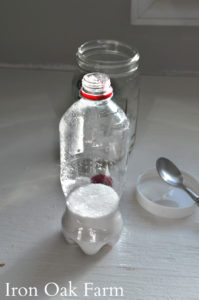 I found an empty 12oz pop bottle and 2 spare water bowls. I filled the pop bottle with around ⅓ rd full of salt and the rest with warm tap water.
I found an empty 12oz pop bottle and 2 spare water bowls. I filled the pop bottle with around ⅓ rd full of salt and the rest with warm tap water.
I filled the bowls with hot water from the tap. And placed the salt water bottle in the first bowl.
The second bowl is the “control” bowl. This is true science-y stuff!
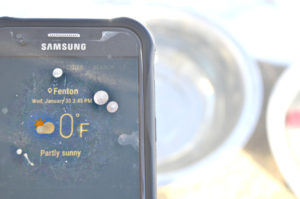 Here’s a terrible photo of my phone showing the temperature where we live.
Here’s a terrible photo of my phone showing the temperature where we live.
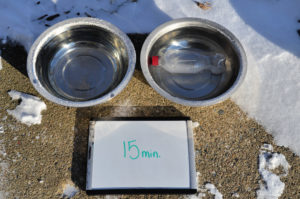
I had heard on the news that frostbite will set in in about 15 minutes of exposure in these temperatures. So I thought that would be a good time interval to check for freezing.
15 minutes: No freezing, the water is lukewarm in both bowls.
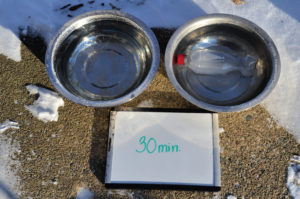 30 minutes: No freezing but the water is very cold
30 minutes: No freezing but the water is very cold
45 minutes: I forgot to check oops!
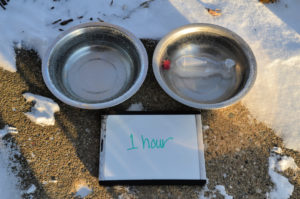 1 hour: Both bowls have equal ice formation on the top.
1 hour: Both bowls have equal ice formation on the top.
 It’s very thin (about ¼ inch) and chickens could easily peck through, but no difference between bowls.
It’s very thin (about ¼ inch) and chickens could easily peck through, but no difference between bowls.
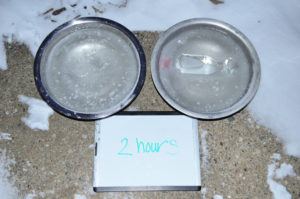 2 hours: both bowls are frozen solid. The salt water is still unfrozen.
2 hours: both bowls are frozen solid. The salt water is still unfrozen.
So somewhere between an hour and 2 hours, the water froze solid.
So what do I conclude from this experiment?
It’s really cold outside!
Also…I feel like perhaps in less severe temperatures this might have worked better. Michigan can have some pretty harsh winter weather, but if you live in a more mild climate and only have a few below freezing days this might work for you. My goal was to put it to the ultimate test because after all…the animals need water on days like today too. And on days like today, I especially don’t want to be hauling buckets of water out every 2 hours.
I’m not sure if different bucket materials might have made a difference. For example, plastic and rubber tend to hold the heat better than aluminum.
I also wonder if the chickens were around the bowls, they might peck at the water and keep it moving. However, it would definitely freeze overnight.
I also wonder if putting the bowls inside the coop may have changed things. We normally don’t like to keep our waterers inside the coop because the splashing causes ice to build up and soggy, frozen bedding.
So in our case, I do feel better about spending the $150 on heated water dishes. However, I’d like to hear from you. Have you tried this? Many people online seem to claim that this works well for their situation. Let me know if it keeps your waterers ice-free and up to what temperatures. What do you do differently if it does work? Leave a comment below!













1 Comment
Yes, tried salt water bottles without success. Use cookie tin water heater.